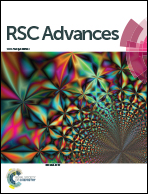Adsorption of arsenic from aqueous solution using a zero-valent iron material modified by the ionic liquid [Hmim]SbF6
Abstract
The environmental and health impacts caused by arsenic (As) in wastewater make it necessary to carefully manage As wastes. In the present work, a composite of the ionic liquid [Hmim]SbF6 and nano-iron (H/Fe) was used as an adsorbent to remove As(V) from aqueous solution. To better understand the removal effect of H/Fe on As(V) in aqueous solution, the reaction parameters of pH, reaction temperature, time and H/Fe dosage were systematically analyzed in detail. The results show that H/Fe has significant removal efficiency toward As(V), and that the adsorption of As(V) by 0.5 g H/Fe reaches its maximum adsorption capacity within 2 h. The adsorption of As(V) on H/Fe is a non-linear, time-varying process. The initial adsorption reaction is fast; however, unlike at the beginning, the later reaction involves sustained slow absorption, resulting in a distinct two-phase adsorption characteristic. Redox reaction may be one of the mechanisms responsible for the slow adsorption of As(V) on H/Fe. At the same time, the As(V) removal effect of H/Fe is greatly restricted by the pH. Electrostatic adsorption, adsorption co-precipitation and redox reactions act together on H/Fe in the As(V) removal process. This study provides a basis for further clarifying the adsorption, adsorption rules and mechanism of As(V) on H/Fe and a feasible method for the improvement of As(V) removal efficiency of zero-valent iron materials.
![Graphical abstract: Adsorption of arsenic from aqueous solution using a zero-valent iron material modified by the ionic liquid [Hmim]SbF6](/en/Image/Get?imageInfo.ImageType=GA&imageInfo.ImageIdentifier.ManuscriptID=D0RA09339D&imageInfo.ImageIdentifier.Year=2021)


 Please wait while we load your content...
Please wait while we load your content...